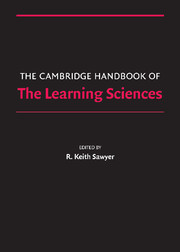Book contents
- Frontmatter
- Contents
- Preface
- Contributors
- 1 Introduction
- PART I FOUNDATIONS
- PART II METHODOLOGIES
- PART III THE NATURE OF KNOWLEDGE
- PART IV MAKING KNOWLEDGE VISIBLE
- PART V LEARNING TOGETHER
- PART VI LEARNING ENVIRONMENTS
- 28 Motivation and Cognitive Engagement in Learning Environments
- 29 Learning as a Cultural Process
- 30 Prospects for Transforming Schools with Technology- Supported Assessment
- 31 Internet Use in Schools
- 32 Teacher Learning Research and the Learning Sciences
- 33 Scaling Up
- 34 Conclusion
- Afterword: After How Comes What
- Epilogue: The Fundamental Issue in the Learning Sciences
- Author Index
- Subject Index
- References
29 - Learning as a Cultural Process
Achieving Equity Through Diversity
Published online by Cambridge University Press: 05 June 2012
- Frontmatter
- Contents
- Preface
- Contributors
- 1 Introduction
- PART I FOUNDATIONS
- PART II METHODOLOGIES
- PART III THE NATURE OF KNOWLEDGE
- PART IV MAKING KNOWLEDGE VISIBLE
- PART V LEARNING TOGETHER
- PART VI LEARNING ENVIRONMENTS
- 28 Motivation and Cognitive Engagement in Learning Environments
- 29 Learning as a Cultural Process
- 30 Prospects for Transforming Schools with Technology- Supported Assessment
- 31 Internet Use in Schools
- 32 Teacher Learning Research and the Learning Sciences
- 33 Scaling Up
- 34 Conclusion
- Afterword: After How Comes What
- Epilogue: The Fundamental Issue in the Learning Sciences
- Author Index
- Subject Index
- References
Summary
In this chapter, we argue that learning and teaching are fundamentally cultural processes (Cole, 1996; Erickson, 2002; Lee, Spencer, & Harpalani, 2003; Rogoff, 2003). The learning sciences have not yet adequately addressed the ways that culture is integral to learning. By “culture,” we mean the constellations of practices historically developed and dynamically shaped by communities in order to accomplish the purposes they value. Such practices are constituted by the tools they use, the social networks with which they are connected, the ways they organize joint activity, the discourses they use and value (i.e., specific ways of conceptualizing, representing, evaluating and engaging with the world). On this view, learning and development can be seen as the acquisition throughout the life course of diverse repertoires of overlapping, complementary, or even conflicting cultural practices.
Through participation in varied communities of practice, individuals appropriate, over time, varied repertoires of cultural practices. As youth make their rounds through the varied settings of their everyday lives – from home to school, mathematics class to English literature class, basketball team to workplace or church youth group – they encounter, engage, and negotiate various situated repertoires of practices. Each repertoire represents a particular point of view on the world, characterized by its own objects, meanings, purposes, symbols, and values (Bakhtin, 1981; Gee, 1990). Navigation among these repertoires can be problematic at any time in any place for any human being.
- Type
- Chapter
- Information
- The Cambridge Handbook of the Learning Sciences , pp. 489 - 504Publisher: Cambridge University PressPrint publication year: 2005
References
- 29
- Cited by

